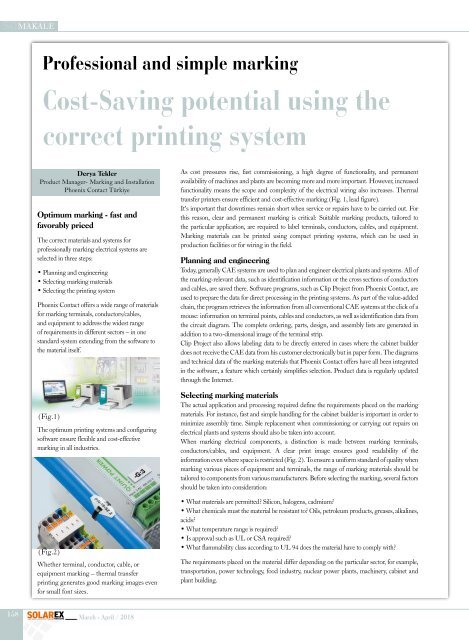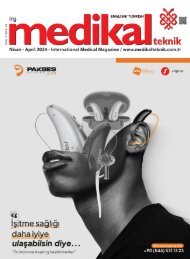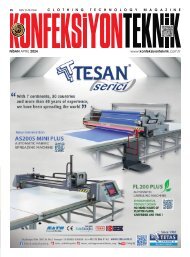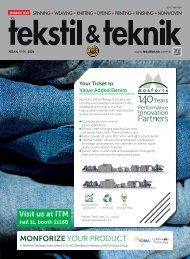You also want an ePaper? Increase the reach of your titles
YUMPU automatically turns print PDFs into web optimized ePapers that Google loves.
MAKALE<br />
Professional and simple marking<br />
Cost-Saving potential using the<br />
correct printing system<br />
Derya Tekler<br />
Product Manager- Marking and Installation<br />
Phoenix Contact Türkiye<br />
Optimum marking - fast and<br />
favorably priced<br />
The correct materials and systems for<br />
professionally marking electrical systems are<br />
selected in three steps:<br />
• Planning and engineering<br />
• Selecting marking materials<br />
• Selecting the printing system<br />
Phoenix Contact offers a wide range of materials<br />
for marking terminals, conductors/cables,<br />
and equipment to address the widest range<br />
of requirements in different sectors – in one<br />
standard system extending from the software to<br />
the material itself.<br />
(Fig.1)<br />
The optimum printing systems and configuring<br />
software ensure flexible and cost-effective<br />
marking in all industries.<br />
(Fig.2)<br />
Whether terminal, conductor, cable, or<br />
equipment marking – thermal transfer<br />
printing generates good marking images even<br />
for small font sizes.<br />
As cost pressures rise, fast commissioning, a high degree of functionality, and permanent<br />
availability of machines and plants are becoming more and more important. However, increased<br />
functionality means the scope and complexity of the electrical wiring also increases. Thermal<br />
transfer printers ensure efficient and cost-effective marking (Fig. 1, lead figure).<br />
It’s important that downtimes remain short when service or repairs have to be carried out. For<br />
this reason, clear and permanent marking is critical: Suitable marking products, tailored to<br />
the particular application, are required to label terminals, conductors, cables, and equipment.<br />
Marking materials can be printed using compact printing systems, which can be used in<br />
production facilities or for wiring in the field.<br />
Planning and engineering<br />
Today, generally CAE systems are used to plan and engineer electrical plants and systems. All of<br />
the marking-relevant data, such as identification information or the cross sections of conductors<br />
and cables, are saved there. Software programs, such as Clip Project from Phoenix Contact, are<br />
used to prepare the data for direct processing in the printing systems. As part of the value-added<br />
chain, the program retrieves the information from all conventional CAE systems at the click of a<br />
mouse: information on terminal points, cables and conductors, as well as identification data from<br />
the circuit diagram. The complete ordering, parts, design, and assembly lists are generated in<br />
addition to a two-dimensional image of the terminal strip.<br />
Clip Project also allows labeling data to be directly entered in cases where the cabinet builder<br />
does not receive the CAE data from his customer electronically but in paper form. The diagrams<br />
and technical data of the marking materials that Phoenix Contact offers have all been integrated<br />
in the software, a feature which certainly simplifies selection. Product data is regularly updated<br />
through the Internet.<br />
Selecting marking materials<br />
The actual application and processing required define the requirements placed on the marking<br />
materials. For instance, fast and simple handling for the cabinet builder is important in order to<br />
minimize assembly time. Simple replacement when commissioning or carrying out repairs on<br />
electrical plants and systems should also be taken into account.<br />
When marking electrical components, a distinction is made between marking terminals,<br />
conductors/cables, and equipment. A clear print image ensures good readability of the<br />
information even where space is restricted (Fig. 2). To ensure a uniform standard of quality when<br />
marking various pieces of equipment and terminals, the range of marking materials should be<br />
tailored to components from various manufacturers. Before selecting the marking, several factors<br />
should be taken into consideration:<br />
• What materials are permitted? Silicon, halogens, cadmium?<br />
• What chemicals must the material be resistant to? Oils, petroleum products, greases, alkalines,<br />
acids?<br />
• What temperature range is required?<br />
• Is approval such as UL or CSA required?<br />
• What flammability class according to UL 94 does the material have to comply with?<br />
The requirements placed on the material differ depending on the particular sector, for example,<br />
transportation, power technology, food industry, nuclear power plants, machinery, cabinet and<br />
plant building.<br />
158<br />
March - April / <strong>2018</strong>

















